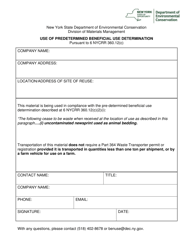This version of the form is not currently in use and is provided for reference only. Download this version of
the document
for the current year.
Beneficial Use Determination Petition - Cement Kiln Feedstock - New York
Beneficial Use Determination Petition - Cement Kiln Feedstock is a legal document that was released by the New York State Department of Environmental Conservation - a government authority operating within New York.
FAQ
Q: What is a Beneficial Use Determination (BUD) petition?
A: A BUD petition is a request to the regulatory agency to determine if a specific material can be used in a beneficial manner.
Q: What is a cement kiln feedstock?
A: A cement kiln feedstock refers to materials that are used as a raw material in the production of cement in cement kilns.
Q: Why would someone submit a BUD petition for cement kiln feedstock?
A: Submitting a BUD petition for cement kiln feedstock allows the petitioner to seek regulatory approval for the use of a specific material in cement production.
Q: Who can submit a BUD petition for cement kiln feedstock in New York?
A: Any person or organization that believes a specific material can be safely and beneficially used as a cement kiln feedstock can submit a BUD petition.
Q: What factors are considered in a BUD petition for cement kiln feedstock?
A: Factors considered in a BUD petition for cement kiln feedstock include the material's composition, potential environmental effects, and potential economic benefits.
Q: What happens after a BUD petition for cement kiln feedstock is submitted?
A: After a BUD petition is submitted, the regulatory agency will review the petition, consider public comments, and make a determination on whether or not to approve the use of the material as a cement kiln feedstock.
Q: Is the use of cement kiln feedstock regulated in New York?
A: Yes, the use of cement kiln feedstock is regulated in New York to ensure the materials used are safe and environmentally sustainable.
Form Details:
- Released on February 21, 2018;
- The latest edition currently provided by the New York State Department of Environmental Conservation;
- Ready to use and print;
- Easy to customize;
- Compatible with most PDF-viewing applications;
- Fill out the form in our online filing application.
Download a printable version of the form by clicking the link below or browse more documents and templates provided by the New York State Department of Environmental Conservation.


















